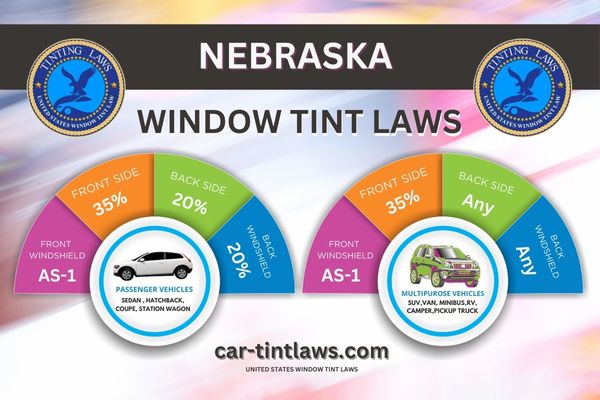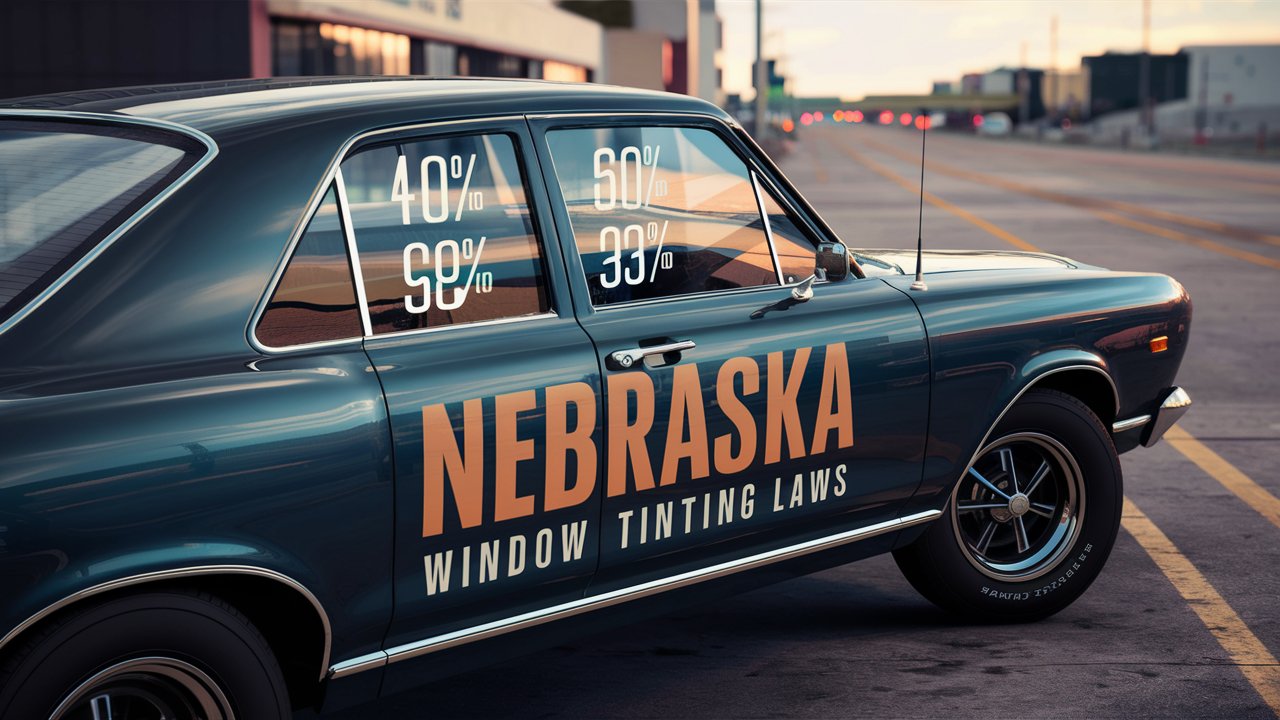When contemplating window tinting for your vehicle in Nebraska, understanding the specific laws that dictate the darkness and reflectiveness of your tints is vital.
For example, sedans have strict rules mandating over 35% light transmission on front side windows, whereas SUVs and vans are permitted any shade on the back side and rear windows.
These regulations are important to prevent fines, and there are even medical exemptions available under specific circumstances.
Are you knowledgeable about the consequences of non-compliance and what actions you may need to take to guarantee your vehicle meets these standards?
Window Tint Darkness in Nebraska
When considering window tint darkness in Nebraska, you’ll want to know the specific VLT% limits for different types of vehicles.
For sedans, the front side windows must allow more light compared to the back side and rear windows.
SUVs and vans have different regulations, permitting darker tints on the back side and rear windows, which can impact both glare reduction and heat rejection.
Tint darkness for sedans:
- Windshield: Non-reflective tint is allowed on the top 6 inches of the windshield.
- Front Side windows: Must allow more than 35% of light in.
- Back Side windows: Must allow more than 20% of light in.
- Rear Window: Must allow more than 20% of light in.
Tint darkness for SUV and Vans:
- Windshield: Non-reflective tint is permitted on the top 6 inches of the windshield.
- Front Side windows: Must allow more than 35% of light in.
- Back Side windows: Any shade can be used.
- Rear window: Any shade can be used
Window Tint Reflection in Nebraska
When it comes to window tint reflection in Nebraska, you’ll need to know the specific limits for different vehicle types.
For sedans, the state has set clear rules on how much reflection is permissible on the front and back side windows to guarantee safety and visibility.
Similarly, SUVs and vans must adhere to regulations that control the amount of reflective tint permitted on their front and back side windows.
Tint reflection for sedans:
- Front Side windows: Must not be more than 20% reflective.
- Back Side windows: Must not be more than 20% reflective.
Tint reflection for SUV and vans:
- Front Side windows: Reflective tint must not exceed certain boundaries to reduce glare and heat.
- Back Side windows: Regulations ensure that visibility is not compromised while enjoying the benefits of reduced heat and glare.
Other Nebraska window tint rules and regulations
- Side Mirrors: No restrictions.
- Restricted Colors: In Nebraska, all tint colors are permitted.
- Certificates: Manufacturers of film need to certify the film they sell in the state. Ask your dealer if they are using certified film.
- Stickers: The sticker/label of compliance to identify legal tinting is required between the film & glass on each tinted window.
- Medical Exceptions: Nebraska does not allow medical exemptions for special tint; all drivers must adhere to standard tint laws.
- Penalties: Violations of tint laws in Nebraska can result in fines.

Medical Exemptions for Window Tint Rules in Nebraska
Nebraska’s window tinting laws include provisions for medical exemptions, guaranteeing individuals with certain light-sensitive conditions can legally apply darker tints.
If you have a medical condition such as albinism, lupus, porphyria, or photophobia, you may qualify for a tinting exemption in Nebraska.
To obtain this exemption, a written prescription from a licensed physician specifying the needed tint percentage is required.
The Nebraska DMV is responsible for issuing special permits based on medical needs.
You’ll need to provide specific documentation to secure compliance with these window tint rules.
Once approved, you’ll receive special stickers that must be displayed on your vehicle to indicate the medical exemption.
This process is designed to balance legal compliance with individual health requirements, guaranteeing that those who need protection from harmful sunlight can still drive legally.
By following these steps, you can ensure that your vehicle meets Nebraska’s regulations while accommodating your medical condition.
This thoughtful approach allows individuals with light-sensitive conditions to maintain their health without violating tinting laws, fostering a sense of community and belonging for those who require these special permits for their wellbeing.
Nebraska Window Tint Ticket Cost
While medical exemptions provide necessary accommodations, it’s equally important to understand the potential financial repercussions of violating.
Nebraska’s window tinting laws. If you’re found in violation of these laws, you could face a Nebraska window tint ticket cost ranging from $50 to $300 depending on the specific violation.
Law enforcement in Nebraska often uses a tint meter to measure the Visible Light Transmission (VLT) of your car window tint during traffic stops to verify compliance.
If you receive a ticket, it may be a fix-it ticket, giving you a designated period to correct the tint to avoid further penalties.
However, if you’re a repeat offender, you could face increased fines and even the potential suspension of your driver’s license.
Understanding Nebraska window tint laws and adhering to them can help you avoid these consequences.
For those with window tint medical exemptions, it’s essential to be aware of the legal advice and documentation required to qualify for such exemptions in Nebraska.
By staying informed about the legal standards and confirming your car window tint meets these regulations, you can avoid costly tickets and potential legal issues.
Nebraska Population and Climate
Nebraska, home to about 1.9 million people, experiences a diverse climate that includes hot summers and cold winters.
This climate variability, along with the state’s low population density and rural living, affects the need for window tinting.
Regional differences in sun exposure, from the humid continental climate in the east to the semi-arid conditions in the west, also play a significant role in determining the appropriate level of tint for vehicles.
Nebraska Demographic Overview
With over 1.9 million residents, mostly in urban areas like Omaha and Lincoln, Nebraska’s population is diverse in both ethnicity and climate experiences.
The state’s demographic makeup includes a mainly Caucasian population, with smaller percentages of Hispanic, African American, and Asian residents.
This diversity influences various aspects of life in Nebraska, from cultural events to community interactions.
Nebraska’s climate also plays a significant role in everyday life.
The state experiences cold winters and hot summers, making temperature control an important concern for many residents.
This is where window tinting laws come into play.
These laws are designed to cater to the state’s varied climate conditions, ensuring drivers can maintain safety and visibility while complying with legal standards.
Understanding Nebraska’s population and climate helps you make informed decisions about window tinting for your vehicle.
In urban areas, where traffic density and sunlight exposure can be high, adhering to window tinting laws is necessary.
These regulations ensure that while you enjoy the benefits of reduced glare and UV protection, you also maintain clear visibility, which is essential for safe driving.
By considering these demographic and climate factors, residents can better navigate the practicalities of window tinting in Nebraska.
Climate Impact on Tint
Understanding how Nebraska’s varied climate influences window tinting can help you optimize comfort and safety in your vehicle.
Nebraska experiences both hot summers and cold winters, conditions that greatly impact interior temperatures.
In the summer, temperatures can soar into the 90s Fahrenheit, causing your vehicle’s interior to become uncomfortably hot.
Tinted windows can mitigate this by blocking out a portion of the sun’s heat, thereby reducing the need for excessive air conditioning.
This not only keeps you cooler but also lowers fuel consumption and vehicle emissions.
Conversely, in the winter, temperatures often drop below freezing, making it essential to retain as much heat as possible inside your vehicle.
While window tinting laws in Nebraska must be followed, having the right level of tint can help maintain a more stable interior temperature.
Besides temperature regulation, window tinting also protects your vehicle’s interior from harmful UV rays, which can cause sun damage over time.
Regional Sun Exposure
Given the importance of temperature regulation, it’s critical to also consider how regional sun exposure affects window tinting effectiveness and overall health in Nebraska.
With a population of approximately 1.9 million, Nebraska residents experience varying levels of sunlight throughout the year.
The state’s climate conditions range from hot summers with intense sunlight to cold winters with limited daylight hours.
Sun exposure in Nebraska is influenced by several factors, including altitude, cloud cover, and proximity to water bodies.
These elements can impact the effectiveness of window tinting in reducing UV exposure and mitigating health risks.
For Nebraska residents, understanding regional sun protection is essential when considering window tinting as a measure to safeguard against harmful UV rays.
Window tinting effectiveness can vary based on the intensity of sunlight and the specific climate conditions in Nebraska.
In the summer, high sun exposure increases the need for effective UV protection, while in the winter, limited daylight might reduce the overall impact.
By considering these factors, Nebraska residents can make informed decisions about window tinting to enhance their health and comfort throughout the year.
References
Nebraska Revised Statutes section 60-6, 257: Windshields and windows; tinting; sun-screening
Frequently Asked Questions
What’s the Darkest Legal Tint in Nebraska?
The darkest legal tint percentage in Nebraska for car windows is 20% VLT for back and rear windows.
You’ll get UV protection, heat reduction, and increased privacy. Make sure your tint shades pass vehicle inspection to stay compliant.
What Is the Legal Tint Limit in Nebraska 2024?
In 2024, Nebraska’s tint percentage limits remain unchanged: 35% for front side windows of all vehicle types, and 20% for rear windows.
DIY removal or professional installation helps avoid enforcement fines, ensuring UV protection and addressing privacy concerns.
How to Get a Tint Exemption in Nebraska?
To get a tint exemption, you’ll need a doctor’s certification for medical conditions. Submit the documentation required to the DMV.
After vehicle inspection, comply with legal requirements. Exemption validity and renewal process make sure you stay compliant.
What Does 35 Tint Look Like?
Imagine cruising on a sunny day with your windows slightly darkened. A 35% tint offers moderate tint darkness while ensuring good tint visibility.
This tint level strikes a balance in tint shades, meeting most tint regulations and keeping your ride stylish.
Conclusion
Nebraska’s window tinting laws require you to guarantee your sedan’s front windows allow over 35% light transmission, while back side and rear windows need more than 20%.
SUVs and vans can have any tint shade on back side and rear windows. Non-reflective tint is only allowed on the top 6 inches of windshields.
Violations result in fines, although medical exemptions are available. Understanding these rules is essential to avoid fines and stay compliant.
